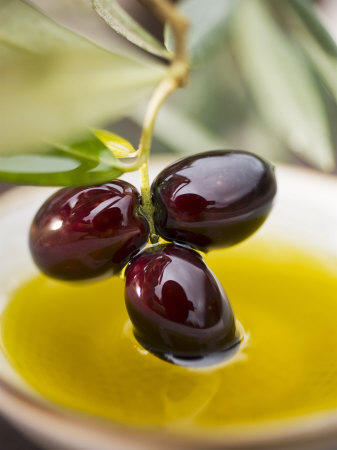 A certain Italian food company made a poll in the Czech Republic regarding the knowledge of olive oil. The results showed that the Czechs don’t know its proper usage. Out of 628 participants (15 to 65 years old) more than half thinks that olive oil is good only for cold dishes such as salads. Some of them even do not like the taste of it.
A certain Italian food company made a poll in the Czech Republic regarding the knowledge of olive oil. The results showed that the Czechs don’t know its proper usage. Out of 628 participants (15 to 65 years old) more than half thinks that olive oil is good only for cold dishes such as salads. Some of them even do not like the taste of it.
The good thing is that 83% of the Czech population does buy it and uses it. But what is there to know about olive oil that is so important?
A/ you can use it for grilling and frying (it starts to burn at 210 degrees Celsius which is 410 degrees F)
B/ you should store it in darkness
C/ you should store it in temperatures that do not go above 20 degrees Celsius which is 68 degrees F)
(Well, I learned something new, I did not know about the temperature requirements. Excuse me, I got to go now, have to rearrange my kitchen supplies :0)
CZ: Pruzkum italske potravinarske spolecnosti nedavno Cechy uplne zahanbil. Ackoliv je o olivovy olej v Cechach stale vetsi zajem, znacna cast populace nevi, jak ho spravne pouzivat. Ze 628 dotazanych (ve veku 15 az 65 let) se vice nez polovina domniva, ze olivovy olej se pouziva pouze k priprave studenych pokrmu. Nekteri ucastnici dokonce ani nemaji jeho typickou chut radi.
Co by tedy podle Italu meli Cesi o tomto oleji vedet?
A/ muze se pouzivat i na grilovani a smazeni (zacne se palit az pri 210 stupnich Celsia) a nejen k priprave studenych pokrmu
B/ mel by se skladovat ve tme, kde teploty nepresahuji 20 stupnu
Musim se priznat, ze jsem vubec o vyse uvedenych teplotnich podminkach nevedela. Pardon, musite me omluvit, je na case preorganizovat si spiz ;0)
Source: http://magazin.ceskenoviny.cz/vareni/zpravy/pruzkum-cesi-neumi-pouzivat-olivovy-olej/553664





I learned the hard way about the burning temperature of olive oil….;)
Also I learned this from a Greek, never buy olive oil in colored glass/plastic container. The really high quality olive oil will be in clear containers because the real deal looks different. They put the low quality oil in colored containers.
As I’m from a town that was known throughout the centuries for its olive oil production, when I first went to my girlfriends town in northern czech with two liters of olive oil, they didn’t know what to do with it, they thought it was only for salads 😛
Antoni, that’s funny! Did they learn to appreciate it? Or did they secretly just poured it down the drain? 😉
Jano, I have read somewhere that it’s the other way – dark colored container protects the oil from light. So now I am all confused. I guess I will just stick with butter…or coconut oil! That’s supposed to be even healthier.
I actually drink the olive oil….And I absolutely love bread soaked in olive oil …
First of all Tanja, they learned o appreciate it, although obviously they still don’t use it as much as I do. Coming from an olive oil producing family we use it for everything, and God knows there’s nothing better than what my girlfriend calls Catalan topinka (toasted round catalan bread, garlic rubbed in the surface, oil soaking the bread and adding a pinch of salt).
As for oil conservation, two things: the traditional thing is to store it in big ceramic containers (think ancient greek style, I still have one) and then have some amount in a glass container (picture here http://ca.wikipedia.org/wiki/Setrill ) which you refill from the ceramic container. Nowadays though, practically everybody buys 5 liter plastic olive oil containers that we store in a cool place like the garage and then refill the “Setrill”.
I hope this long explanation helped clear some doubts 😉
Antoni, I agree with you on that toasted bread. The Czechs would pot few drops of soy sauce on top :))
So I have seen olive oil in cans too. Would that be the improvisation on those ceramic bottles?
Would you buy those dark bottled oils or it doesn’t matter?
I’m in general not a big fan of cans., although I don’t think it’s gonna be better or worse than plastic. Ceramic is the traditional way of storing it but, as much as I know that unglazed ceramic is the best way to store water, for it permeates the pores of the clay, creating a thermic exchange with the outside that cools the water (8-15 degrees in hot mediterranean summer), I’m not sure the same principle applies to the oil storage.
In regards to the dark bottled oils… generally it’s all a marketing thing. Farmers here will sell the best quality oil in regular plastic containers which then people store as they like, but generally at our olive oil consumption rate leaving them on the plastic is alright. What’s important is not to shake much with it so the bigger particles gradually go to the botom and not to the food.
Of course, you can expect this sort of culinary ignorance from a nation that puts ketchup on spaghetti and pizza.
Czechs not only don’t know about olive oil, they also don’t know about Olive Oyl. They think her name is “Olivia”.
Well, Jamie, I’ve never seen this crime of putting ketchup on a pizza, but unfortunately I witnessed the other offense (ketchup on spaghetti) quite often. The Czechs I know, are aware of Olive oil, they just had never tried to use it extensively, and thus, did not care much for it.
Hi Jamie! Glad you are back! I am so glad you raised that ketchup-on-pasta issue. I am sorrry but that is truly my deepest craving from my childhood years. I love it! My mom would make plain pasta with ground beef and put a half a bottle of catchup on top and some cheese (doubt it was Parmesan) and then I would get to mix it all in, turn on my favorite TV show and finished that whole plate..and of course I would lick it at the end too.
Up to this date – and I hope my husband is not reading this – I put a couple of squirts of catchup into every single tomato sauce I make. And he says I am a good cook so it can’t be that bad!
What a cooking secret for spaghetti! In my westernized taste (which doesn’t really like ketchup on spaghetti), I’ve tasted probably worse. In the Philippines, some of us put ketchup in our spaghetti sauce. The ones who know better about spaghetti don’t use ketchup but use herbs and add a little sugar to tone down the sour tomato sauce.
In the Philippines, their use of olive oil is roughly similar to the USA. They always are in clear glass bottles in supermarkets, imported from Spain or Italy. Those who use it are the upper middle-class to the rich people who enjoy Mediterranean food.
We use it either as a component of salad dressing or as cooking oil or ingredient for some famous Italian or Spanish dishes.
Other than that, we don’t use it extensively as we see it as foreign, classy but pricey and a bit exotic.
The only new thing I learned from you in this blog is item c, which says that it must be stored at 20 deg. Celsius. We can only do that from December to February. Temperatures normally hit 30 degrees, 37 if it’s hot.